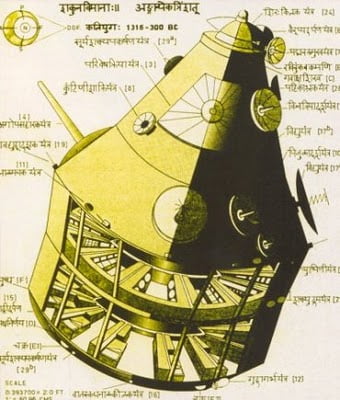
A few years ago, reports surfaced on the Internet of a “vimana” discovered by the United States military in a cave somewhere in Afghanistan. As incredible as that, itself, sounds, the vimana was also allegedly encased in a “time well,” leading to the disappearance of at least eight soldiers who attempted to retrieve it.
Hard to believe? Sure, but it’s an intriguing story nonetheless. Much like the history of the ancient flying vimanas themselves.
The Origin of the Ancient Vimanas
The word vimana, in Sanskrit, means “measuring out” or “traversing.” The term is used to describe palaces, temples, and in many cases flying palaces or otherworldly aerial machines known as “Chariots of the Gods.” Point being, “vimana” does appear in ancient Indian texts and Epics, the Vedas, the Ramayana, the Mahabharata, etc.
However, when we hear about vimanas in paranormal circles, particularly of the Ancient Aliens sort, we’re probably venturing into that murky territory where truth and fantasy often converge. In this case, that territory would be the Vaimānika Shāstra.

The Vaimānika Shāstra is a curious text, not only for its contents, but for the way it came about. The title translates to “shastra on the topic of the vimanas” and it’s not so ancient; it was written, in Sanskrit, in the early 20th Century, sometime during the years 1918 to 1923. But it wasn’t simply written. Of course not.
According to G. R. Josyer, who brought the text to public attention in 1952, the Vaimānika Shāstra was psychically channeled by the mystic Subbaraya Shastry, who attributed its actual (spiritually-obtained) contents to Bharadvaja, an ancient Hindu sage.
Exploring the Vaimānika Shāstra

According to the Vaimānika Shāstra, the vimanas of the ancient texts were actually true aerodynamic flying machines, propelled by what some claim were “mercury vortex engines.”
Inside are details of the construction of these “unbreakable” machines, as well as a number of “secrets,” such as turning the machines invisible, making them motionless, and performing supernatural abilities like causing your enemies to lose consciousness or photographing the insides of their planes.
The text was translated to Hindi in 1959, and later to English in 1973.
In 1974, mechanical engineers at the Indian Institute of Science in Bangalore concluded that the contents of the Vaimānika Shāstra displayed nothing more than “poor concoctions” and a complete lack of understanding of simple aeronautics. The vimanas, as described, could not fly.
And yet, despite its dubious nature, the Vaimānika Shāstra is often used as a source of evidence for the true existence of the ancient flying vimanas.
Back to Afghanistan
So what of that vimana found in Afghanistan and encased in a time well? That’s hard to say. Allegedly, a number of world leaders visited Afghanistan at the time to discuss the ramifications of finding such ancient technology. And there were even more extraordinary claims, that the “time well” was a kind of gravity field predicted by the work of Albert Einstein, and somehow linked to the Philadelphia Experiment.
In reality, however, the story could have something to do with a 2008 film called The Objective, which similarly deals with a group of Special Forces who encounter vimanas in the mountains of Afghanistan. Perhaps it was viral marketing. Or, maybe, it’s just a good old fashioned hoax.
I honestly can’t tell, anymore.

